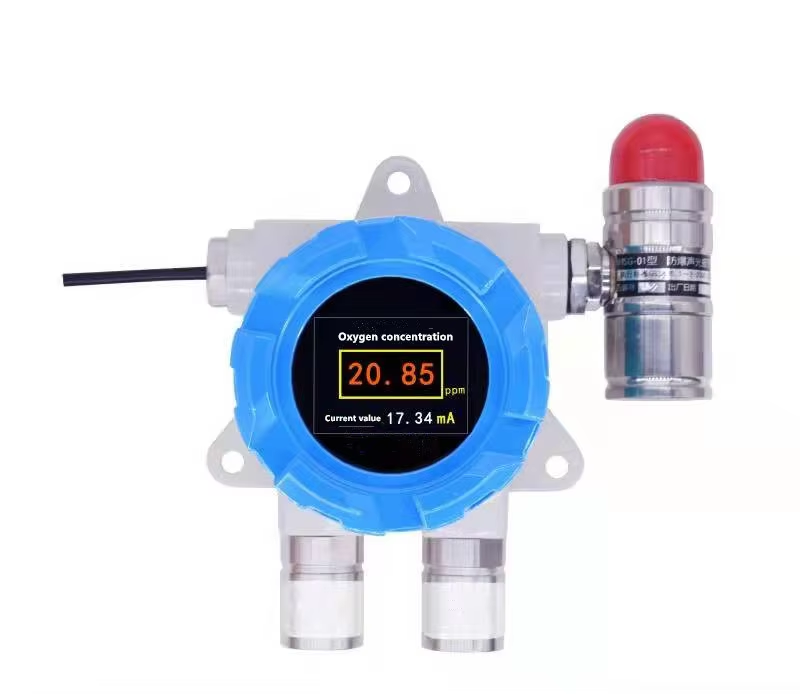Explosion-proof gas sensors play a critical role in industrial safety across Kazakhstan. The following is a detailed analysis of their real-world applications, challenges, and solutions in the country.
Industrial Context and Needs in Kazakhstan
Kazakhstan is a major player in the oil, gas, mining, and chemical industries. Work environments in these sectors often present risks from combustible gases (methane, VOCs), toxic gases (Hydrogen Sulfide H₂S, Carbon Monoxide CO), and oxygen deficiency. Therefore, explosion-proof gas sensors are mandatory equipment for ensuring personnel safety, preventing catastrophic accidents, and maintaining continuous production.
The Importance of Explosion-Proof Certification: In Kazakhstan, such equipment must comply with local technical regulations and widely accepted international explosion-proof certifications, such as ATEX (EU) and IECEx (International) standards, to guarantee their safety in hazardous environments.
Real Application Cases
Case 1: Oil & Gas Upstream Extraction – Drilling Rigs and Wellheads
- Location: Major oil and gas fields like Tengiz, Kashagan, and Karachaganak.
- Application Scenario: Monitoring combustible gases and Hydrogen Sulfide (H₂S) on drilling platforms, wellhead assemblies, separators, and gathering stations.
- Challenges:
- Extreme Environment: Severe winter cold (below -30°C), summer dust/sandstorms, demanding high weather resistance from equipment.
- High H₂S Concentration: Crude oil and natural gas in many fields contain high concentrations of highly toxic H₂S, where even a small leak can be fatal.
- Continuous Monitoring: The production process is continuous; any interruption causes significant economic loss, requiring sensors to operate reliably and stably.
- Solutions:
- Installation of Intrinsically Safe or Flameproof fixed gas detection systems.
- Sensors use Catalytic Bead (LEL) principle for combustibles and Electrochemical cells for H₂S and O₂ deficiency.
- These sensors are strategically placed in potential leak areas (e.g., near valves, flanges, compressors).
- Outcome:
- When gas concentrations reach a preset low alarm level, audible and visual alarms are immediately triggered in the control room.
- Upon reaching a high alarm level, the system can automatically initiate emergency shutdown procedures (ESD), such as closing valves, activating ventilation, or shutting down processes, preventing fires, explosions, or poisoning.
- Workers are also equipped with portable explosion-proof gas detectors for confined space entry and routine inspections.
Case 2: Natural Gas Transmission Pipelines & Compressor Stations
- Location: Compressor stations and valve stations along the trans-Kazakhstan pipeline networks (e.g., Central Asia-Center pipeline).
- Application Scenario: Monitoring for methane leaks at compressor halls, regulator skids, and pipeline junctions.
- Challenges:
- Hard-to-Detect Leaks: High pipeline pressure means even minor leaks can quickly become hazardous.
- Unmanned Stations: Many remote valve stations are unmanned, requiring remote monitoring and self-diagnostic capabilities.
- Solutions:
- Use of Infrared (IR) absorption principle explosion-proof combustible gas sensors. These are unaffected by oxygen-deficient atmospheres and have a long lifespan, making them ideal for natural gas (primarily methane).
- Integration of sensors into SCADA (Supervisory Control and Data Acquisition) systems for remote data transmission and centralized monitoring.
- Outcome:
- Enables 24/7 monitoring of critical infrastructure. The central control room can immediately locate a leak and dispatch a repair team, significantly reducing response time and securing the safety of the national energy artery.
Case 3: Coal Mining – Underground Gas Monitoring
- Location: Coal mines in regions like Karaganda.
- Application Scenario: Monitoring for firedamp (primarily methane) and carbon monoxide concentrations in mine roadways and working faces.
- Challenges:
- Extremely High Explosion Risk: Methane accumulation is a primary cause of coal mine explosions.
- Harsh Environment: High humidity, heavy dust, and potential mechanical impact.
- Solutions:
- Deployment of Mining Intrinsically Safe methane sensors, specially designed to withstand the harsh underground conditions.
- Formation of a dense sensor network with real-time data transmission to the surface dispatch center.
- Outcome:
- When methane concentration exceeds the safe threshold, the system automatically cuts power to the affected section and triggers evacuation alarms, effectively preventing methane explosions.
- Simultaneous carbon monoxide monitoring helps detect early signs of spontaneous combustion in coal seams.
Case 4: Chemical and Oil Refineries
- Location: Refineries and chemical plants in cities like Atyrau and Shymkent.
- Application Scenario: Monitoring for various flammable and toxic gases in reactor areas, tank farms, pump areas, and loading/unloading bays.
- Challenges:
- Wide Variety of Gases: Beyond standard combustibles, specific toxic gases like benzene, ammonia, or chlorine may be present.
- Corrosive Atmosphere: Vapors from certain chemicals can corrode sensors.
- Solutions:
- Use of multi-gas detectors, where a single head can monitor combustible gases and 1-2 specific toxic gases simultaneously.
- Equipping sensors with dustproof/waterproof (IP-rated) housings and corrosion-resistant filters.
- Outcome:
- Provides comprehensive gas safety monitoring for complex chemical processes, protecting plant employees and surrounding communities, and ensuring compliance with Kazakhstan’s increasingly stringent industrial safety and environmental regulations.
Summary
In Kazakhstan, explosion-proof gas sensors are far from ordinary instruments; they are a ”lifeline” for industrial safety. Their real-world applications permeate every corner of the energy and heavy industries, directly impacting personnel safety, the protection of billions of dollars in assets, and the nation’s economic stability.
With advancing technology, sensors featuring smart capabilities, wireless connectivity, longer lifespan, and enhanced self-diagnostics are becoming the new trend in both new projects and upgrades within Kazakhstan, further solidifying the foundation of safe production in this resource-rich nation.
Complete set of servers and software wireless module, supports RS485 GPRS /4g/WIFI/LORA/LORAWAN
please contact Honde Technology Co., LTD.
Email: info@hondetech.com
Company website: www.hondetechco.com
Tel: +86-15210548582
Post time: Sep-30-2025


